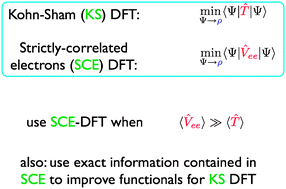Density functional theory for strongly-interacting electrons: perspectives for physics and chemistry
Abstract
Improving the accuracy and thus broadening the applicability of electronic density functional theory (DFT) is crucial to many research areas, from material science, to theoretical chemistry, biophysics and biochemistry. In the last three years, the mathematical structure of the strong-interaction limit of density functional theory has been uncovered, and exact information on this limit has started to become available. The aim of this paper is to give a perspective on how this new piece of exact information can be used to treat situations that are problematic for standard Kohn–Sham DFT. One way to use the strong-interaction limit, more relevant for solid-state physical devices, is to define a new framework to do practical, non-conventional, DFT calculations in which a strong-interacting reference system is used instead of the traditional non-interacting one of Kohn and Sham. Another way to proceed, more related to chemical applications, is to include the exact treatment of the strong-interaction limit into approximate exchange–correlation energy density functionals in order to describe difficult situations such as the breaking of the chemical bond.


 Please wait while we load your content...
Please wait while we load your content...